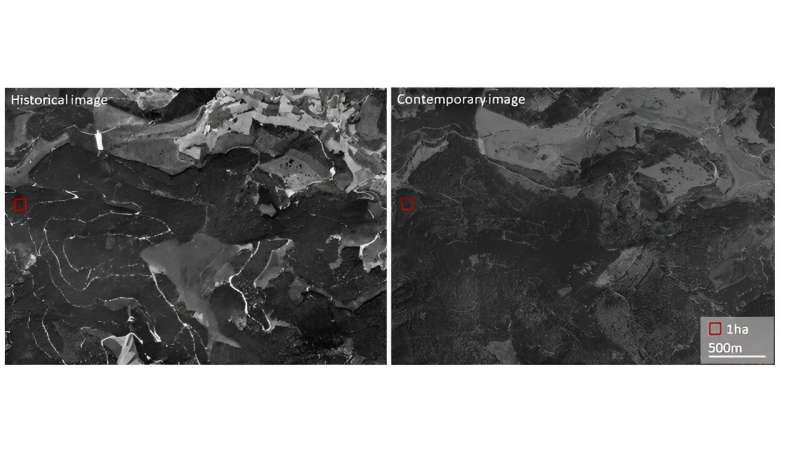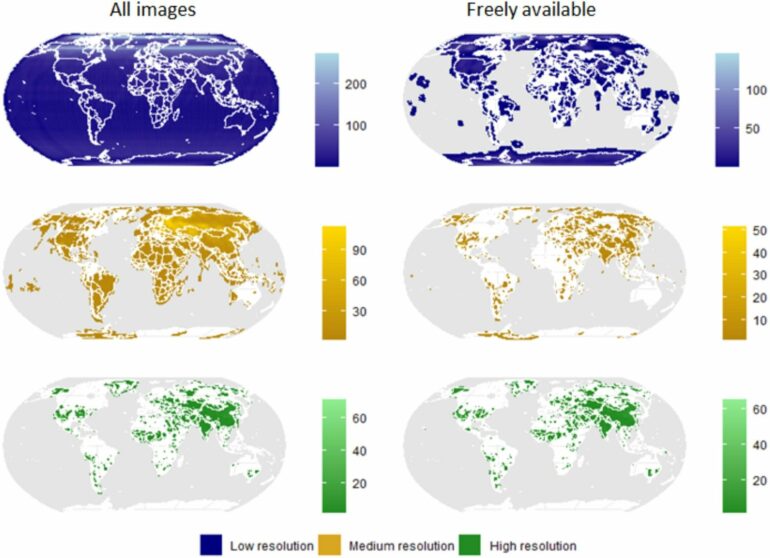A large number of historical spy-satellite photographs from the Cold War Era were declassified decades ago. This valuable remote sensing data has been utilized by scientists across a wide range of disciplines from archaeology to civil engineering. However, its use in ecology and conservation remains limited.
A new study led by Dr. Catalina Munteanu from the Faculty of Environment and Natural Resources at the University of Freiburg, Germany, aims to advance the application of declassified satellite data in the fields of ecology and conservation.
Leveraging recent progress in image processing and analysis, these globally available black-and-white images can offer better insights into the historical changes of ecosystems, species populations or changes in human influences on the environment dating back to the 1960s, the researchers suggest.
Historical satellite images cover nearly the entire globe across all seasons
In their study, the researchers initially evaluated the spatial, temporal, and seasonal coverage of more than 1 million declassified images from four historical U.S. spy-satellite programs, showing that this data spans nearly the entire globe and is available across all seasons.
Upon reviewing how spy-satellite imagery is currently employed in ecology-related fields, the team then identified potential future applications. Crucially, the broad spatial-temporal scale of the satellite images could enhance the understanding of ecological concepts such as shifting baselines, lag effects, and legacy effects.
This improved understanding could lead to better mapping of the historical extent and structure of ecosystems, aid in the reconstruction of past habitats and species distributions as well as offer new insights into historical human impacts on present ecosystem conditions.
Going forward, this knowledge can also be helpful for conservation planning and ecosystem restoration efforts by helping identify, for example, meaningful ecological baselines, the researchers explain.

A large forest clearcut from the 1960s in the vicinity of a one-hectare forest research plot in the Southern Black Forest Region. Although much of the area is forested today, historical harvests have changed the forest structure and composition. Left: Historical spy-satellite image. Right: Current Google Earth Image. © University of Freiburg
Challenges to overcome
However, the use of spy-satellite data in ecological research faces several challenges. The study highlights issues such as limited access to and sharing of data, high costs, the necessity of pre-processing and rectifying images, and the absence of consistent workflows within the scientific community.
To address these challenges, the researchers call for collaborative efforts between data holders, remote sensing experts, and the ecological research community.
“This piece is a call for interdisciplinary collaboration between ecologists, conservationists, and remote sensing specialists to explore the full potential of these incredible datasets. Our few prior studies have revealed that without considering the past, we may draw erroneous conclusions about the current state of the environment,” says Munteanu.
In a 2020 study that attracted international media attention, a research group led by the same scientists had already presented an example of how satellite images can be used in ecology to reveal unexpected declines in steppe marmot populations due to historical agricultural conversions.
“To enable these scientific inquiries, we call on support from the data holders in releasing and pre-processing the data,” adds Munteanu.
More information:
Catalina Munteanu et al, The potential of historical spy-satellite imagery to support research in ecology and conservation, BioScience (2024). DOI: 10.1093/biosci/biae002
Provided by
University of Freiburg
Citation:
Spy satellite images offer insights into historical ecosystem changes (2024, February 19)



